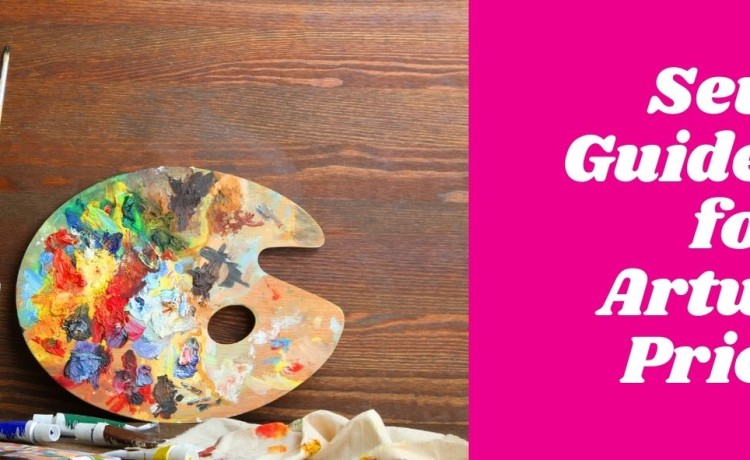As artists, You know the making aspect of your profession like the back of your hand. You could certainly produce a respectable-looking painting while wearing blinders. You have honed your trade for tens of thousands of hours. The phase that follows the application of the last finishing touch to an artwork—pricing—is what we frequently struggle with.
Pricing is a challenge. Even more unpleasant is trying to put a price on something that is so deeply personal and doesn’t have a clear market value.
You want (and need) to generate sales, especially at the beginning of your art practice or if you don’t have a savings account to fall back on, but you also don’t want to undersell yourself.
How then do you go about determining the costs for your artwork so that you can be compensated fairly?
Follow these seven guidelines to begin started if you don’t have a regular history of selling your art in a certain price range or market.
1. Do some study on similar art.
We now have access to a tonne of data, which helps us establish prices a little bit more easily, thanks to the internet. Put on your study hat and begin looking for artists who have works that are comparable to what you are currently creating.
What are the prices for the work of these artists? Is this pricing consistent throughout?
You’ll have a better notion of what you can and should charge if you look for artists who produce similar work. Make sure you are evaluating your work objectively and contrasting it with the work of other artists who have your style, medium, level of expertise, and sell in the same geographic area.
Lean into the idea that artists are known for talking about money when you are next at a dinner party with other creative people and ask your successful friends for advice. Find out how much they are charging for their creations and why. Your pricing will be on track if you have open and sincere conversations about money.
2. Self-pay at a decent wage
Overworking and underselling yourself are the two things that will burn you out the fastest. Artwork creation is expensive. There are pricey art supplies, and studio space to consider.
Work backwards from the hourly wage you would consider reasonable and comfortable. The average artist pay in Australia is 77,515 AUD per year, or $39.75 per hour. Use this information to help you estimate. In the US the average hourly wage for a fine artist at 34.41 USD. Be thorough when keeping track of the time it takes you to complete a painting, and then account for overhead and material costs.
Of all, you may take considerably longer than an established artist in your area while you are just getting started. On the other hand, when you have mastered the craft, you might finish a task in a lot less time and be able to charge a lot more for it.
In conclusion, while not a fool-proof approach, this is a decent place to start when determining the value of your work.
3. Price your art consistently
Make sure you are comparing your work to pieces that are also available for direct purchase from the artist if you aren’t currently working with a gallery. Some galleries up your price by 50%. Keep in mind that galleries will take a sales fee of 30% to 50% if you don’t set your prices to include it.
However, if you do have representation and are considering offering your studio sales at a discount from your gallery, reconsider. Galleries invest time and effort into their sales, so they are typically unhappy to hear that you have been selling your work for much less.
Additionally, if other galleries find out, they might be less likely to collaborate with you. Make sure your studio and your galleries have defined prices that are typically the same. In this manner, customers can buy your artwork from your studio or the gallery, and you can keep amicable connections with your galleries.
However, if you are succeeding in the online sales world, you might not need to take this commission into account since more and more people are purchasing art online and straight from artists on Instagram.
4. Distinguish emotions from reality
This one is difficult. However, telling a prospective customer that you just truly like the painting will not be sufficient justification for your art price. Consider retaining a piece for yourself if you have strong feelings about it, if it has a unique importance to you, or if it has sentimental worth.
It’s simple to become devoted to your work since you put so much time, creativity, and emotion into it. After finishing your work, take a break to get some perspective. After that, treat your pricing like you would any other product. A scaling formula is a favourite tool of some artists. Your work should be priced primarily based on its tangible qualities rather than on your own worth.
5. Have several price points for your work
Higher-priced paintings might turn off some potential buyers. More people can afford smaller, more affordable things. Additionally, they are more affordable for customers who cannot afford more expensive work. For instance, a young consumer may be able to afford a $200 painting but not a $2000 one. Still, they get to bring a piece of your creation home and fall in love with it. Your work will already be on their minds when they have more money for art in the future.
Prints are an excellent method for customers to feel as though they are bringing a piece of your artwork home. Despite not being the original, a print might nevertheless be rather large. Additionally, the price is substantially lower. It allows cautious purchasers to dabble in the market. When they feel more at ease, they can upgrade to a more pricey piece of art.
Your art will receive greater exposure the more sales it receives. More people will notice it, discuss it, and be curious to learn more about you. This implies that there is a greater likelihood that more people will wish to purchase your work. Your selection of pricing points can increase sales and goodwill since people will be pleased to own one of your items.
6. Be open and honest about your pricing.
A collector’s mind automatically raises a red flag when you have to ask for a price. It raises red flags about the possibility that you may alter your prices depending on the person asking, their perceived amount of interest, and their apparent wealth. Your honesty is demonstrated by making your prices clear, accessible, and available on your sales platforms.
Additionally, it saves you from having a lot of potentially awkward talks if you detest talking about money. By providing that knowledge up front, the buyer must do all the difficult decision-making. They will have enough time to choose an item that fits their budget before approaching you to complete the simple transaction.
Your own website or the art gallery that promotes you are two simple ways to display your work and inspire confidence in your customers. It lets you choose which information is made public, incorporates links to the artwork, and provides alternatives for possible buyers to get in touch with you or the gallery that represents you.
7. Stand firmly behind your charges by offering proof.
Have faith in yourself and your prices, regardless of how much of your work you sell or how new you are to the market. Buyers will rapidly figure it out if you don’t.
Have a prepared response ready for the next time someone questions why something is so pricey (they always do). Show them that you’ve been selling comparable paintings for that price on a regular basis. Disclose your provenance records, or print them out, to demonstrate the comparable sales you have made from galleries, dealers, and your studio. People want to be able to provide clear, unambiguous evidence to support their purchase. They want to be certain that their financial decisions are sound.
Put their minds at ease by demonstrating to them that similar Sold art pieces have been made by others, that your labour is valued, and that your pricing strategy is methodical and fact-based.
You can stand behind the price when you take the time to accurately and realistically price your work. You’ll be prepared to defend your price if the buyer wants to offer less than that. You’ll get home with the money you deserve if you have confidence, which works wonders.
Want to learn more?
- Just starting out? CLICK HERE
- Been working in your business for two years or more? CLICK HERE
Click here if you need to schedule a meeting with me.
We’re here to help you to take action just like we’ve helped thousands of other entrepreneurs, business owners and creative professionals all around the globe.
Now is the time to let your passion SHINE.
Now is the time to Make Tomorrow Today!
To your success,
Vinh Van Lam & Stuart Horrex





